Pebax-Based Composite Membranes with High Transport Properties Enhanced by ZIF-8 for CO2 Separation
Abstract
:1. Introduction
2. Material and Methods
2.1. Chemicals
2.2. Membrane Preparation
2.3. Thermal Characterization (TGA and DSC)
2.4. Scanning Electron Microscopy (SEM-EDX)
2.5. Gas Permeation Measurements
3. Results and Discussion
3.1. Effect of PEG Molecular Weight on Pebax/PEG Blend Membranes
3.1.1. Morphology of Membranes
3.1.2. Thermal Analysis
3.1.3. Gas Permeation Measurements
3.2. Effect of ZIF-8 and PEG on Pebax Based Membranes
3.2.1. Morphology
3.2.2. Thermal Analysis
3.2.3. Gas Permeation Measurements
3.3. Effect of Temperature on Permeation Properties
4. Conclusions
Author Contributions
Funding
Institutional Review Board Statement
Data Availability Statement
Acknowledgments
Conflicts of Interest
References
- Jiao, C.; Li, Z.; Li, X.; Wu, M.; Jiang, H. Improved CO2/N2 separation performance of Pebax composite membrane containing polyethyleneimine functionalized ZIF-8. Sep. Purif. Technol. 2021, 259, 118190. [Google Scholar] [CrossRef]
- Songolzadeh, M.; Soleimani, M.; Ravanchi, M.T.; Songolzadeh, R. Carbon Dioxide Separation from Flue Gases: A Technological Review Emphasizing Reduction in Greenhouse Gas Emissions. Sci. World J. 2014, 2014, 828131 . [Google Scholar] [CrossRef] [PubMed]
- Galizia, M.; Chi, W.S.; Smith, Z.P.; Merkel, T.C.; Baker, R.W.; Freeman, B.D. 50th Anniversary Perspective: Polymers and Mixed Matrix Membranes for Gas and Vapor Separation: A Review and Prospective Opportunities. Macromolecules 2017, 50, 7809–7843. [Google Scholar] [CrossRef]
- Anjum, M.W.; de Clippel, F.; Didden, J.; Khan, A.L.; Couck, S.; Baron, G.V.; Denayer, J.F.; Sels, B.; Vankelecom, I. Polyimide mixed matrix membranes for CO2 separations using carbon–silica nanocomposite fillers. J. Membr. Sci. 2015, 495, 121–129. [Google Scholar] [CrossRef]
- Baker, R.W.; Low, B.T. Gas Separation Membrane Materials: A Perspective. Macromolecules 2014, 47, 6999–7013. [Google Scholar] [CrossRef]
- Kim, H.W.; Yoon, H.W.; Yoo, B.M.; Park, J.S.; Gleason, K.L.; Freeman, B.D.; Park, H.B. High-performance CO2-philic graphene oxide membranes under wet-conditions. Chem. Commun. 2014, 50, 13563–13566. [Google Scholar] [CrossRef] [PubMed]
- Hirsch, A.; Backes, C. Carbon Nanotube Science. Synthesis, Properties and Applications. By Peter J. F. Harris. Angew. Chem. Int. Ed. 2010, 49, 1722–1723. [Google Scholar] [CrossRef]
- Furukawa, H.; Cordova, K.E.; O’Keeffe, M.; Yaghi, O.M. The Chemistry and Applications of Metal-Organic Frameworks. Science 2013, 341, 1230444. [Google Scholar] [CrossRef]
- Wang, S.; Li, X.; Wu, H.; Tian, Z.; Xin, Q.; He, G.; Peng, D.; Chen, S.; Yin, Y.; Jiang, Z.; et al. Advances in high permeability polymer-based membrane materials for CO2 separations. Energy Environ. Sci. 2016, 9, 1863–1890. [Google Scholar] [CrossRef]
- Sforça, M.; Yoshida, I.; Nunes, S. Organic–inorganic membranes prepared from polyether diamine and epoxy silane. J. Membr. Sci. 1999, 159, 197–207. [Google Scholar] [CrossRef]
- Shamsabadi, A.A.; Seidi, F.; Salehi, E.; Nozari, M.; Rahimpour, A.; Soroush, M. Efficient CO2-removal using novel mixed-matrix membranes with modified TiO2 nanoparticles. J. Mater. Chem. A 2017, 5, 4011–4025. [Google Scholar] [CrossRef]
- Selyanchyn, R.; Fujikawa, S. Membrane thinning for efficient CO2 capture. Sci. Technol. Adv. Mater. 2017, 18, 816–827. [Google Scholar] [CrossRef] [PubMed]
- Gong, X.; Wang, Y.; Kuang, T. ZIF-8-Based Membranes for Carbon Dioxide Capture and Separation. ACS Sustain. Chem. Eng. 2017, 5, 11204–11214. [Google Scholar] [CrossRef]
- Huang, G.; Isfahani, A.P.; Muchtar, A.; Sakurai, K.; Shrestha, B.B.; Qin, D.; Yamaguchi, D.; Sivaniah, E.; Ghalei, B. Pebax/ionic liquid modified graphene oxide mixed matrix membranes for enhanced CO2 capture. J. Membr. Sci. 2018, 565, 370–379. [Google Scholar] [CrossRef]
- Zhao, D.; Ren, J.; Wang, Y.; Qiu, Y.; Li, H.; Hua, K.; Li, X.; Ji, J.; Deng, M. High CO2 separation performance of Pebax®/CNTs/GTA mixed matrix membranes. J. Membr. Sci. 2017, 521, 104–113. [Google Scholar] [CrossRef]
- Kargari, A.; Rezaeinia, S. State-of-the-art modification of polymeric membranes by PEO and PEG for carbon dioxide separation: A review of the current status and future perspectives. J. Ind. Eng. Chem. 2019, 84, 1–22. [Google Scholar] [CrossRef]
- Wang, M.; Wang, Z.; Zhao, S.; Wang, J.; Wang, S. Recent advances on mixed matrix membranes for CO2 separation. Chin. J. Chem. Eng. 2017, 25, 1581–1597. [Google Scholar] [CrossRef]
- Lin, H.; Freeman, B. Gas solubility, diffusivity and permeability in poly(ethylene oxide). J. Membr. Sci. 2004, 239, 105–117. [Google Scholar] [CrossRef]
- Askari, M.; Chung, T.-S. Natural gas purification and olefin/paraffin separation using thermal cross-linkable co-polyimide/ZIF-8 mixed matrix membranes. J. Membr. Sci. 2013, 444, 173–183. [Google Scholar] [CrossRef]
- Nafisi, V.; Hägg, M.-B. Development of dual layer of ZIF-8/PEBAX-2533 mixed matrix membrane for CO2 capture. J. Membr. Sci. 2014, 459, 244–255. [Google Scholar] [CrossRef]
- Jomekian, A.; Behbahani, R.M.; Mohammadi, T.; Kargari, A. CO2/CH4 separation by high performance co-casted ZIF-8/Pebax 1657/PES mixed matrix membrane. J. Nat. Gas Sci. Eng. 2016, 31, 562–574. [Google Scholar] [CrossRef]
- Nordin, N.A.H.M.; Ismail, A.F.; Mustafa, A.; Murali, R.S.; Matsuura, T. The impact of ZIF-8 particle size and heat treatment on CO2/CH4 separation using asymmetric mixed matrix membrane. RSC Adv. 2014, 4, 52530–52541. [Google Scholar] [CrossRef]
- Duan, C.; Jie, X.; Liu, D.; Cao, Y.; Yuan, Q. Post-treatment effect on gas separation property of mixed matrix membranes containing metal organic frameworks. J. Membr. Sci. 2014, 466, 92–102. [Google Scholar] [CrossRef]
- Thompson, J.A.; Chapman, K.W.; Koros, W.J.; Jones, C.W.; Nair, S. Sonication-induced Ostwald ripening of ZIF-8 nanoparticles and formation of ZIF-8/polymer composite membranes. Microporous Mesoporous Mater. 2012, 158, 292–299. [Google Scholar] [CrossRef]
- Jeazet, H.B.T.; Sorribas, S.; Román-Marín, J.M.; Zornoza, B.; Téllez, C.; Coronas, J.; Janiak, C. Increased Selectivity in CO2/CH4 Separation with Mixed-Matrix Membranes of Polysulfone and Mixed-MOFs MIL-101(Cr) and ZIF-8. Eur. J. Inorg. Chem. 2016, 2016, 4363–4367. [Google Scholar] [CrossRef]
- Zheng, X.; Xu, Q. Comparison Study of Morphology and Crystallization Behavior of Polyethylene and Poly(ethylene oxide) on Single-Walled Carbon Nanotubes. J. Phys. Chem. B 2010, 114, 9435–9444. [Google Scholar] [CrossRef]
- Wang, S.; Liu, Y.; Huang, S.; Wu, H.; Li, Y.; Tian, Z.; Jiang, Z. Pebax–PEG–MWCNT hybrid membranes with enhanced CO2 capture properties. J. Membr. Sci. 2014, 460, 62–70. [Google Scholar] [CrossRef]
- Car, A.; Stropnik, C.; Yave, W.; Peinemann, K.-V. PEG modified poly(amide-b-ethylene oxide) membranes for CO2 separation. J. Membr. Sci. 2008, 307, 88–95. [Google Scholar] [CrossRef]
- Li, M.; Zhang, X.; Zeng, S.; Bai, L.; Gao, H.; Deng, J.; Yang, Q.; Zhang, S. Pebax-based composite membranes with high gas transport properties enhanced by ionic liquids for CO2 separation. RSC Adv. 2017, 7, 6422–6431. [Google Scholar] [CrossRef]
- Firpo, G.; Angeli, E.; Repetto, L.; Valbusa, U. Permeability thickness dependence of polydimethylsiloxane (PDMS) membranes. J. Membr. Sci. 2015, 481, 1–8. [Google Scholar] [CrossRef] [Green Version]
- Rutherford, S.W.; Do, D.D. Review of time lag permeation technique as a method for characterisation of porous media and membranes. Adsorption 1997, 3, 283–312. [Google Scholar] [CrossRef]
- Wu, H.; Thibault, J.; Kruczek, B. The validity of the time-lag method for the characterization of mixed-matrix membranes. J. Membr. Sci. 2020, 618, 118715. [Google Scholar] [CrossRef]
- Choudalakis, G.; Gotsis, A. Free volume and mass transport in polymer nanocomposites. Curr. Opin. Colloid Interface Sci. 2012, 17, 132–140. [Google Scholar] [CrossRef]
- Thanakkasaranee, S.; Kim, D.; Seo, J. Preparation and Characterization of Poly(ether-block-amide)/Polyethylene Glycol Composite Films with Temperature-Dependent Permeation. Polymers 2018, 10, 225. [Google Scholar] [CrossRef] [PubMed]
- Reijerkerk, S.R.; Knoef, M.H.; Nijmeijer, D.C.; Wessling, M. Poly(ethylene glycol) and poly(dimethyl siloxane): Combining their advantages into efficient CO2 gas separation membranes. J. Membr. Sci. 2010, 352, 126–135. [Google Scholar] [CrossRef]
- Meshkat, S.; Kaliaguine, S.; Rodrigue, D. Enhancing CO2 separation performance of Pebax® MH-1657 with aromatic carboxylic acids. Sep. Purif. Technol. 2019, 212, 901–912. [Google Scholar] [CrossRef]
- Feng, S.; Ren, J.; Zhao, D.; Li, H.; Hua, K.; Li, X.; Deng, M. Effect of poly(ethylene glycol) molecular weight on CO2/N2 separation performance of poly(amide-12-b-ethylene oxide)/poly(ethylene glycol) blend membranes. J. Energy Chem. 2019, 28, 39–45. [Google Scholar] [CrossRef]
- Chung, T.-S.; Jiang, L.Y.; Li, Y.; Kulprathipanja, S. Mixed matrix membranes (MMMs) comprising organic polymers with dispersed inorganic fillers for gas separation. Prog. Polym. Sci. 2007, 32, 483–507. [Google Scholar] [CrossRef]
- Ghadimi, A.; Mohammadi, T.; Kasiri, N. A Novel Chemical Surface Modification for the Fabrication of PEBA/SiO2 Nanocomposite Membranes to Separate CO2 from Syngas and Natural Gas Streams. Ind. Eng. Chem. Res. 2014, 53, 17476–17486. [Google Scholar] [CrossRef]
- Loloei, M.; Omidkhah, M.; Moghadassi, A.; Amooghin, A.E. Preparation and characterization of Matrimid® 5218 based binary and ternary mixed matrix membranes for CO2 separation. Int. J. Greenh. Gas Control 2015, 39, 225–235. [Google Scholar] [CrossRef]
- Ahmadpour, E.; Sarfaraz, M.V.; Behbahani, R.M.; Shamsabadi, A.A.; Aghajani, M. Fabrication of mixed matrix membranes containing TiO 2 nanoparticles in Pebax 1657 as a copolymer on an ultra-porous PVC support. J. Nat. Gas Sci. Eng. 2016, 35, 33–41. [Google Scholar] [CrossRef]
- Jomekian, A.; Bazooyar, B.; Behbahani, R.M.; Mohammadi, T.; Kargari, A. Ionic liquid-modified Pebax® 1657 membrane filled by ZIF-8 particles for separation of CO2 from CH4, N2 and H2. J. Membr. Sci. 2017, 524, 652–662. [Google Scholar] [CrossRef]
- Sutrisna, P.D.; Hou, J.; Li, H.; Zhang, Y.; Chen, V. Improved operational stability of Pebax-based gas separation membranes with ZIF-8: A comparative study of flat sheet and composite hollow fibre membranes. J. Membr. Sci. 2017, 524, 266–279. [Google Scholar] [CrossRef]
- Dechnik, J.; Sumby, C.J.; Janiak, C. Enhancing Mixed-Matrix Membrane Performance with Metal–Organic Framework Additives. Cryst. Growth Des. 2017, 17, 4467–4488. [Google Scholar] [CrossRef]
- Aguilar-Armenta, G.; Hernandez-Ramirez, G.; Flores-Loyola, E.; Ugarte-Castaneda, A.; Silva-Gonzalez, R.; Tabares-Munoz, C.; Jimenez-Lopez, A.; Rodriguez-Castellon, E. Adsorption Kinetics of CO2, O2, N2, and CH4 in Cation-Exchanged Clinoptilolite. J. Phys. Chem. B 2001, 105, 1313–1319. [Google Scholar] [CrossRef]
- Rahman, M.; Filiz, V.; Shishatskiy, S.; Abetz, C.; Neumann, S.; Bolmer, S.; Khan, M.M.; Abetz, V. PEBAX® with PEG functionalized POSS as nanocomposite membranes for CO2 separation. J. Membr. Sci. 2013, 437, 286–297. [Google Scholar] [CrossRef]
- Shen, J.; Liu, G.; Huang, K.; Li, Q.; Guan, K.; Li, Y.; Jin, W. UiO-66-polyether block amide mixed matrix membranes for CO2 separation. J. Membr. Sci. 2016, 513, 155–165. [Google Scholar] [CrossRef]
- Zarshenas, K.; Raisi, A.; Aroujalian, A. Mixed matrix membrane of nano-zeolite NaX/poly (ether-block-amide) for gas separation applications. J. Membr. Sci. 2016, 510, 270–283. [Google Scholar] [CrossRef]
- Ghosal, K.; Freeman, B.D. Gas separation using polymer membranes: An overview. Polym. Adv. Technol. 1994, 5, 673–697. [Google Scholar] [CrossRef]
- Kim, J.H.; Ha, S.Y.; Lee, Y.M. Gas permeation of poly(amide-6-b-ethylene oxide) copolymer. J. Membr. Sci. 2001, 190, 179–193. [Google Scholar] [CrossRef]

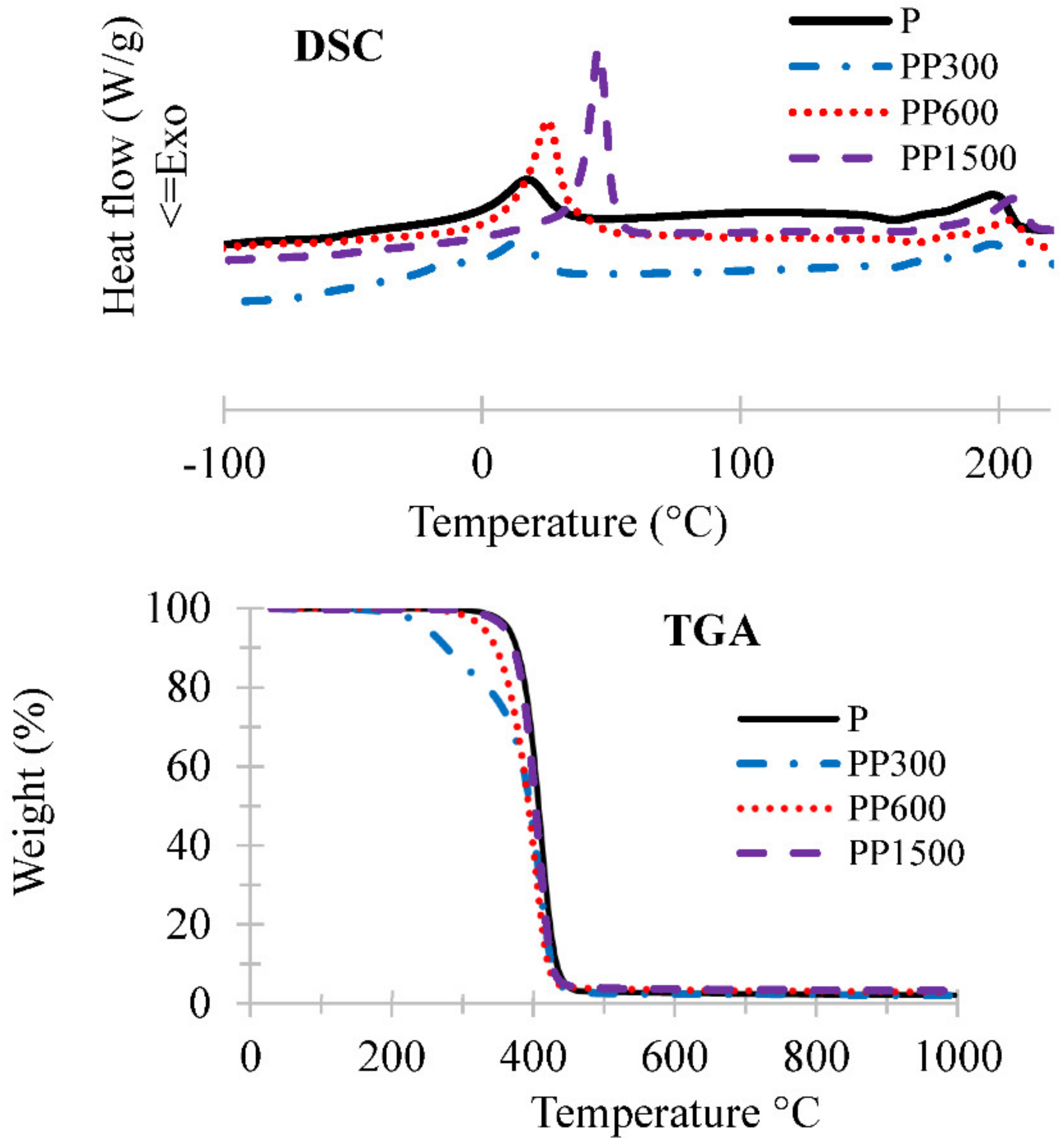
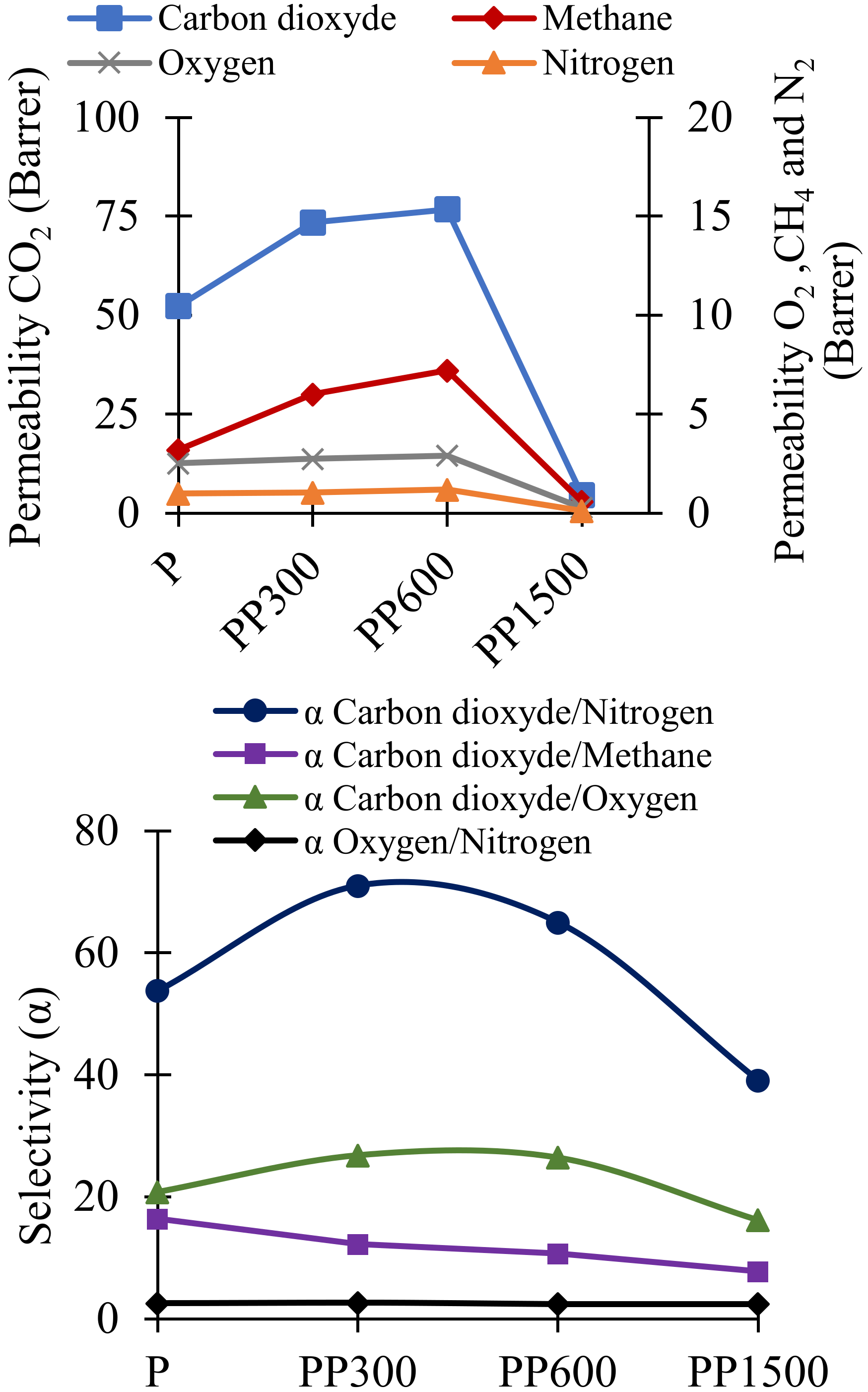

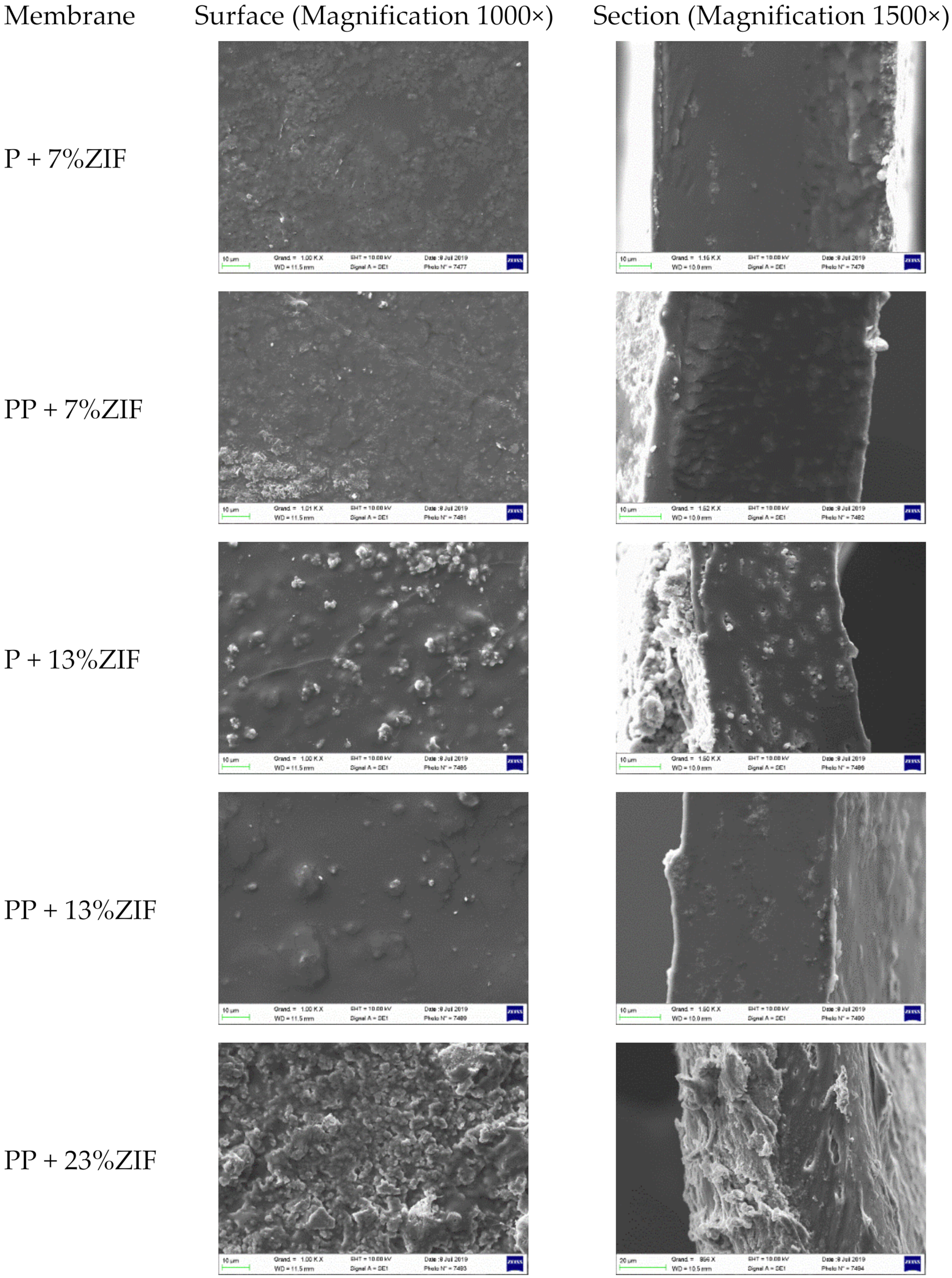

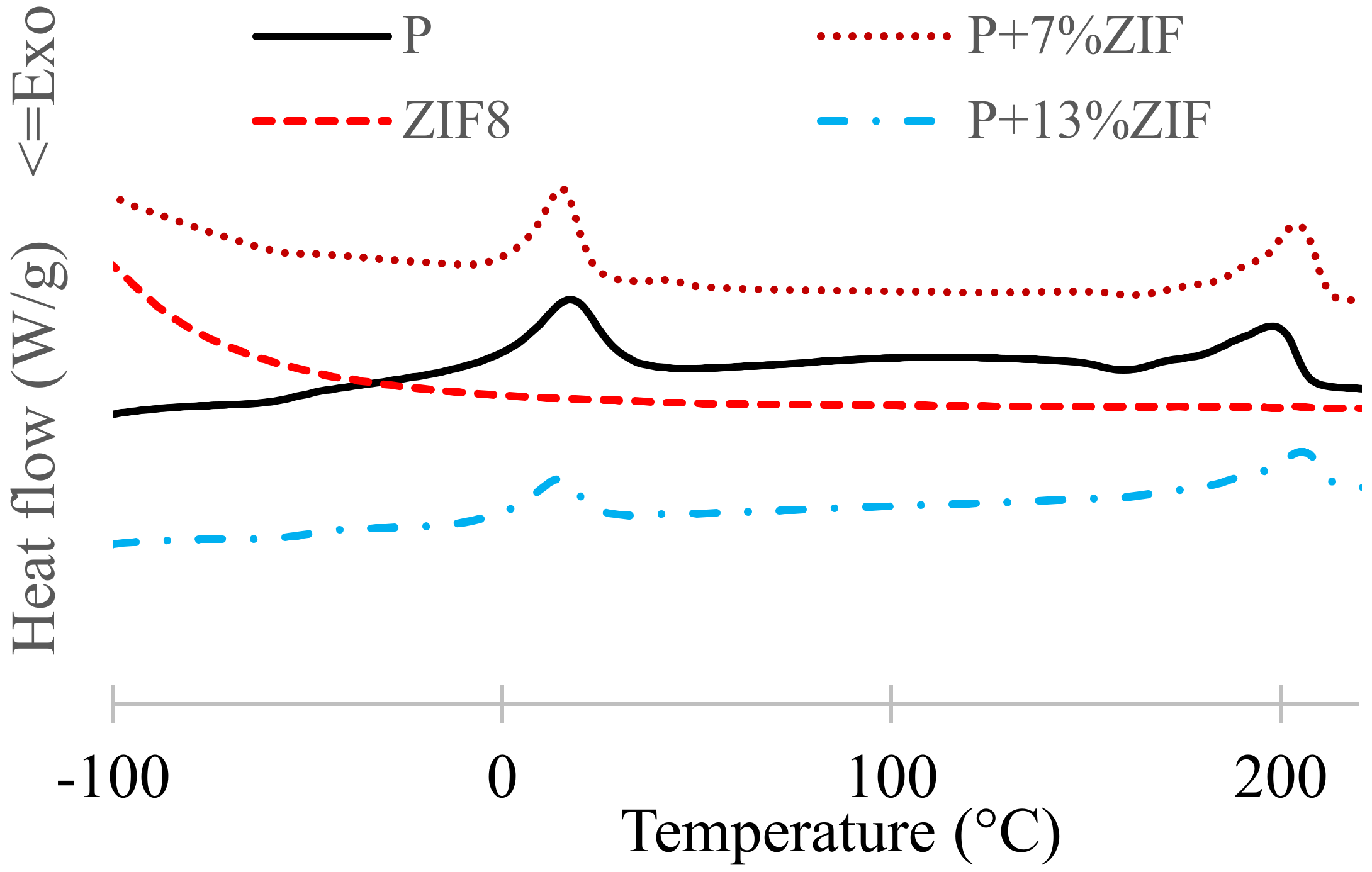
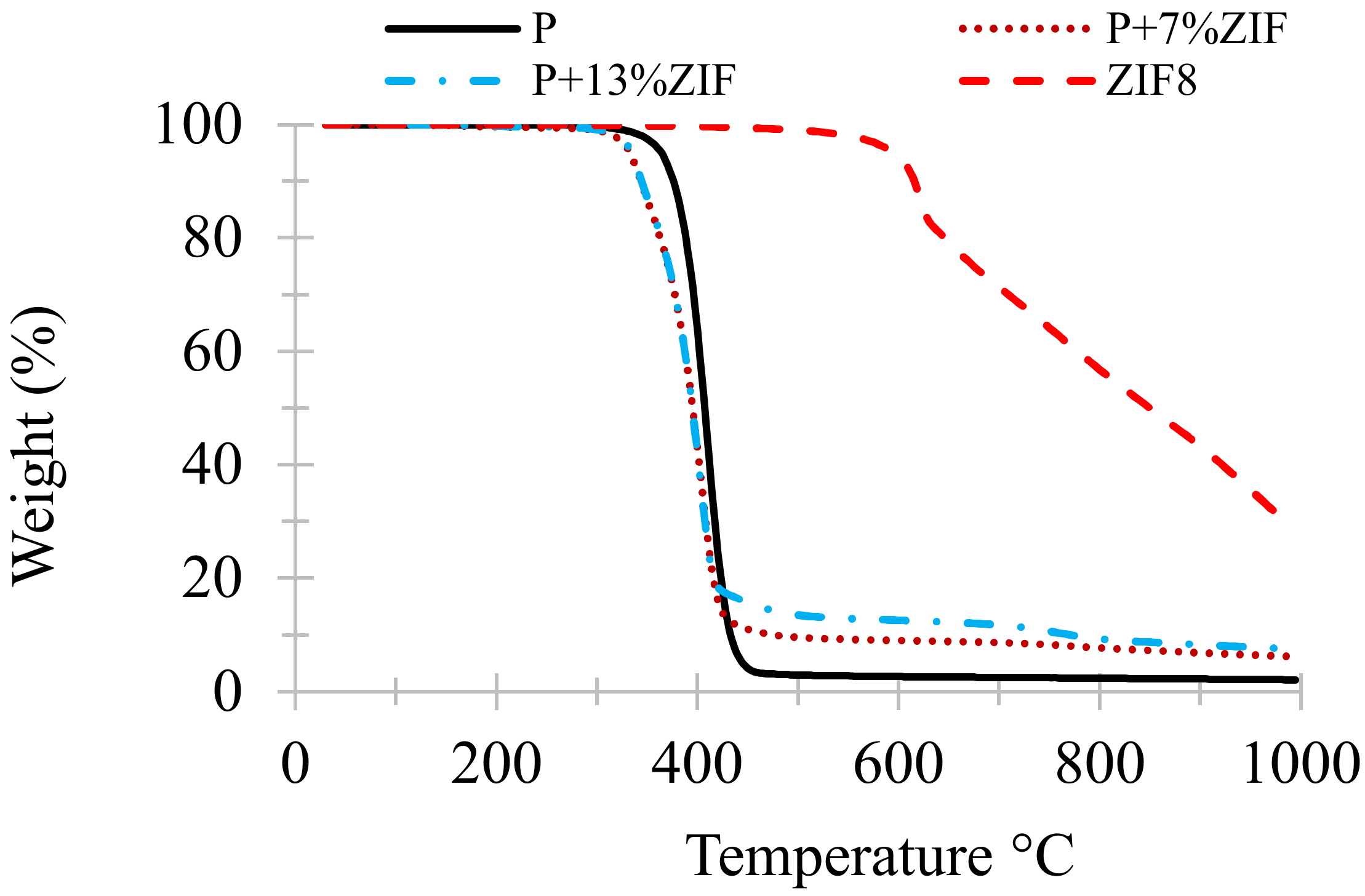

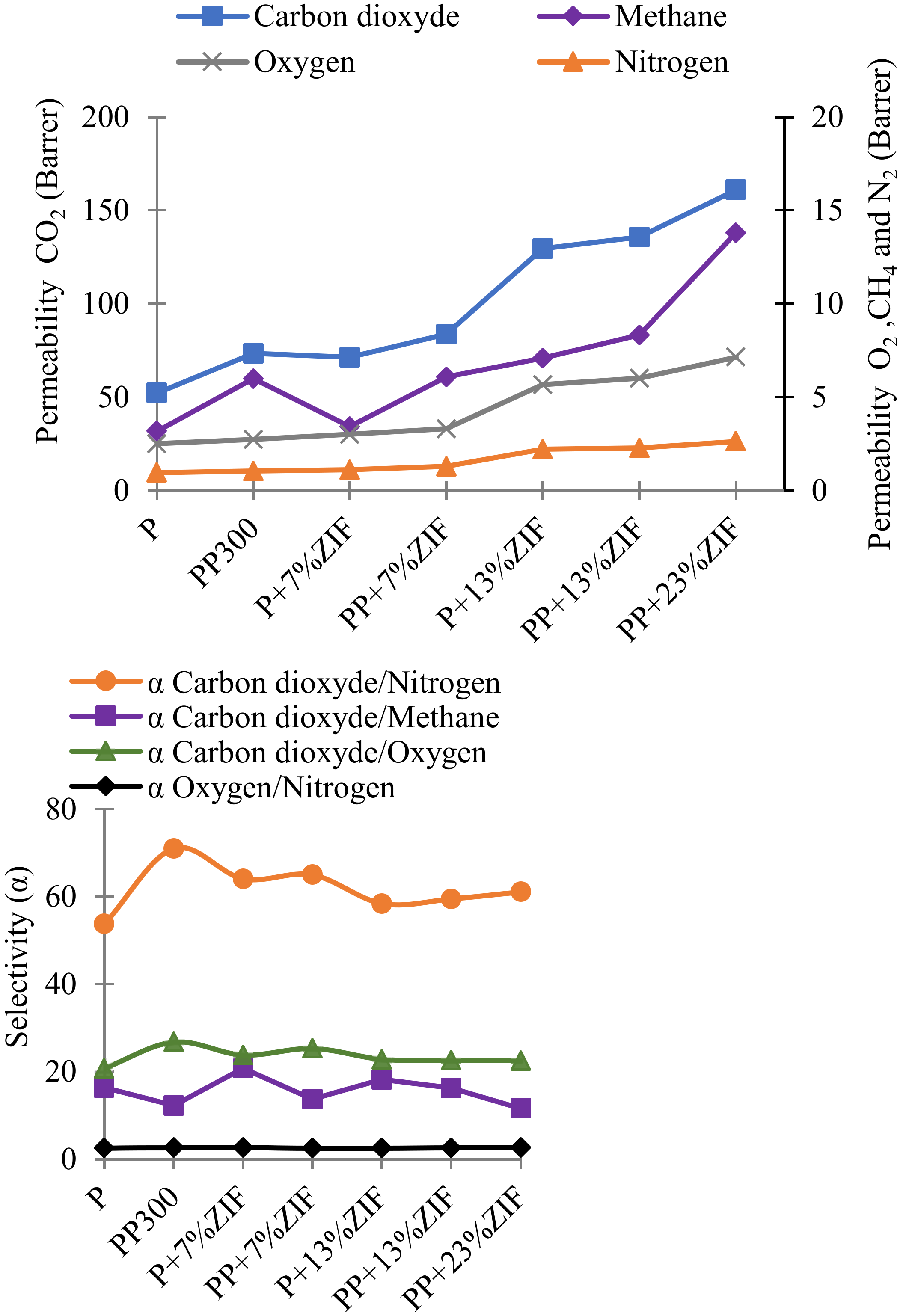
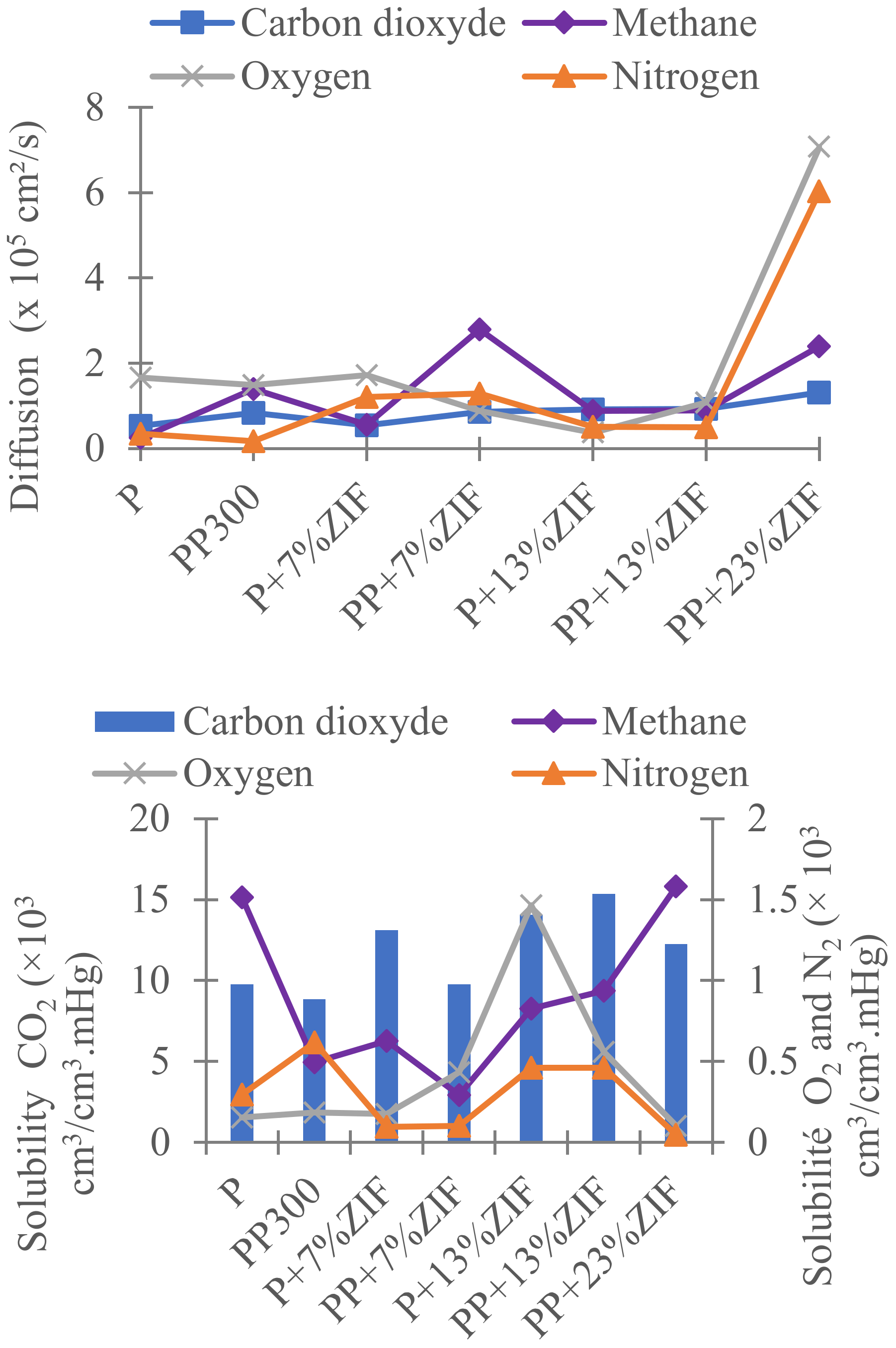

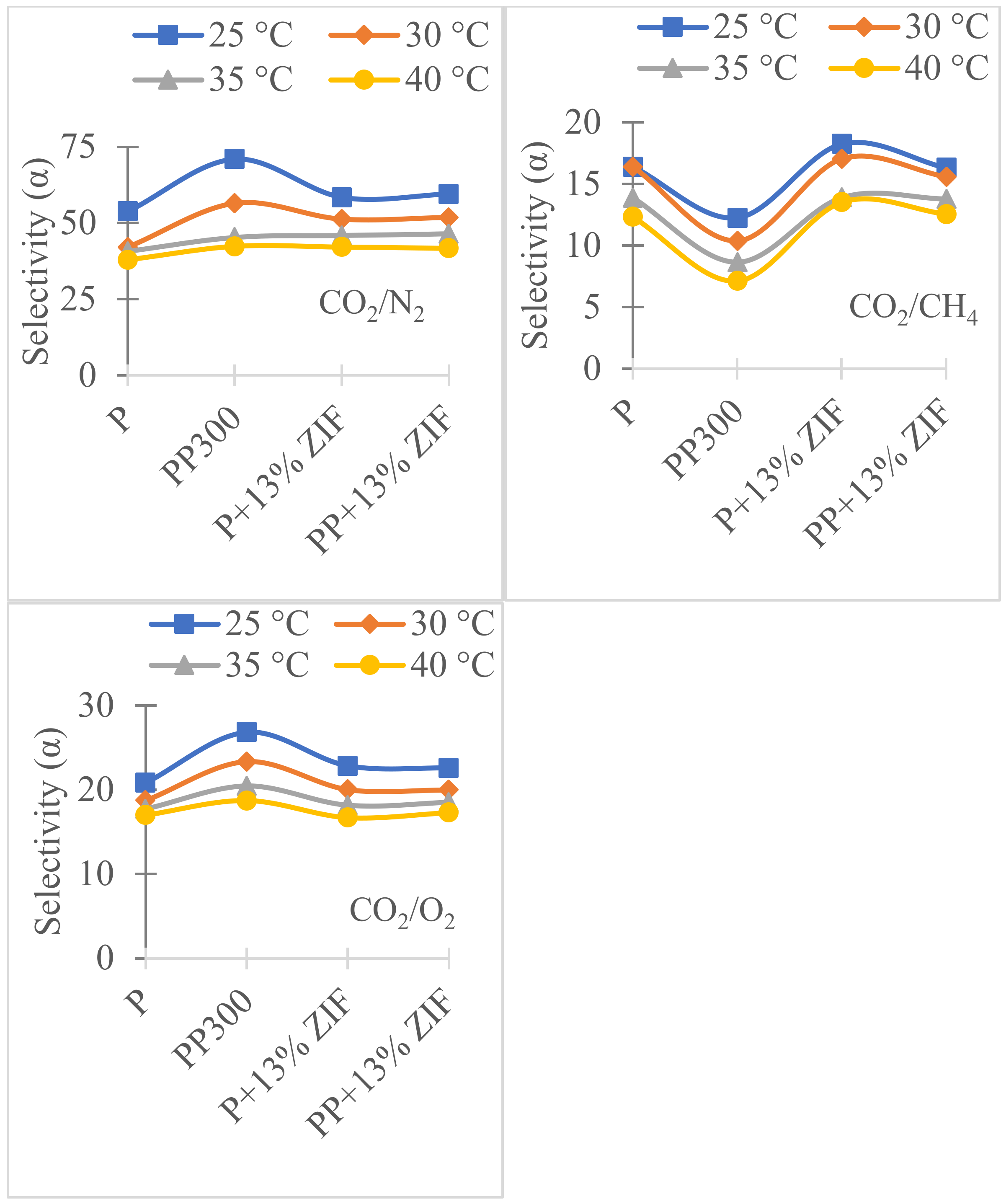
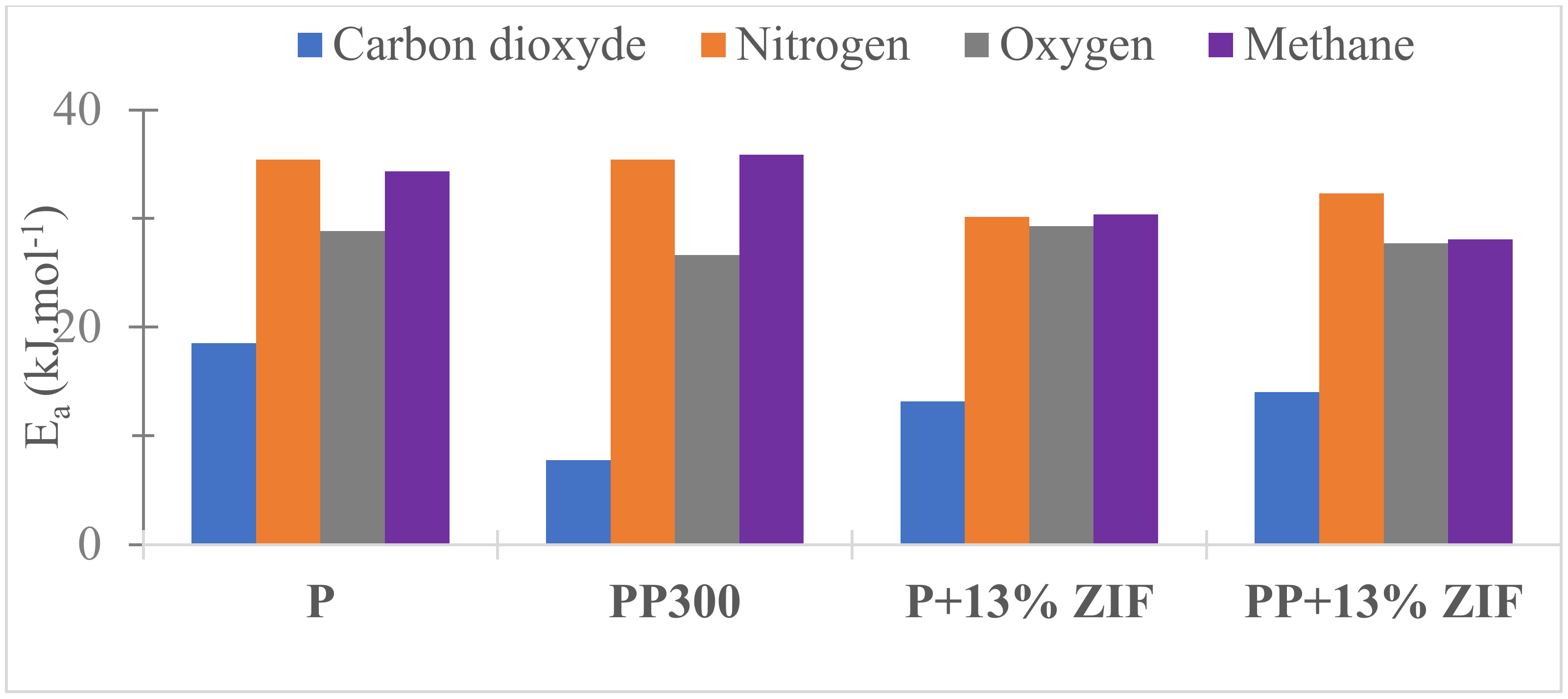
| Membrane | Pebax (wt%) | PEG (wt%) | ZIF-8 (wt%) | ZIF-8/Pebax (wt%) |
|---|---|---|---|---|
| P | 100 | - | - | - |
| PP300 | 67 | 33 | - | - |
| PP600 | 67 | 33 | - | - |
| PP1500 | 67 | 33 | - | - |
| P + 7% ZIF | 93 | - | 7 | 7 |
| PP + 7% ZIF | 64 | 32 | 4 | 7 |
| P + 13% ZIF | 87 | - | 13 | 13 |
| PP + 13% ZIF | 61 | 30 | 9 | 13 |
| PP + 23% ZIF | 56 | 28 | 16 | 23 |
| TGA | DSC | ||||||||
|---|---|---|---|---|---|---|---|---|---|
| Membrane | T1% (°C) | T5% (°C) | DTG (°C) | R (%) | Tg (°C) | Tm PEO (°C) | Tm PA (°C) | Xc PEO (%) | Xc PA (%) |
| P | 327 | 364 | 410 | 2.1 | −49 | 18 | 198 | 14 | 11 |
| PP 300 | 197 | 248 | 405 | 2.1 | −70 | 14 | 198 | 14 | 7 |
| PP 600 | 287 | 330 | 407 | 2.8 | −61 | 26 | 204 | 34 | 8 |
| PP 1500 | 318 | 359 | 411 | 3.2 | −50 | 45 | 206 | 49 | 9 |
| TGA | DSC | ||||||||
|---|---|---|---|---|---|---|---|---|---|
| Membrane | T1% (°C) | T5% (°C) | DTG (°C) | R (%) | Tg (°C) | Tm PEO (°C) | Tm PA (°C) | Xc PEO (%) | Xc PA (%) |
| P | 327 | 364 | 410 | 2.1 | −49 | 18 | 198 | 14 | 11 |
| PP 300 | 197 | 248 | 405 | 2.1 | −70 | −20–35 | 198 | 14 | 7 |
| P + 7% ZIF | 299 | 333 | 406 | 6.2 | −47 | 15 | 204 | 11 | 11 |
| PP + 7% ZIF | 194 | 254 | 399 | 5.4 | −65 | −20–50 | 201 | 36 | 9 |
| P + 13% ZIF | 305 | 334 | 398 | 7.5 | −47 | 15 | 205 | 8 | 6 |
| PP + 13% ZIF | 179 | 243 | 401 | 6.8 | N.D. | −20–50 | 204 | 7 | 6 |
| PP + 23% ZIF | 172 | 242 | 396 | 9.6 | −58 | 10–50 | 202 | 12 | 6 |
Publisher’s Note: MDPI stays neutral with regard to jurisdictional claims in published maps and institutional affiliations. |
© 2022 by the authors. Licensee MDPI, Basel, Switzerland. This article is an open access article distributed under the terms and conditions of the Creative Commons Attribution (CC BY) license (https://creativecommons.org/licenses/by/4.0/).
Share and Cite
Eljaddi, T.; Bouillon, J.; Roizard, D.; Lebrun, L. Pebax-Based Composite Membranes with High Transport Properties Enhanced by ZIF-8 for CO2 Separation. Membranes 2022, 12, 836. https://doi.org/10.3390/membranes12090836
Eljaddi T, Bouillon J, Roizard D, Lebrun L. Pebax-Based Composite Membranes with High Transport Properties Enhanced by ZIF-8 for CO2 Separation. Membranes. 2022; 12(9):836. https://doi.org/10.3390/membranes12090836
Chicago/Turabian StyleEljaddi, Tarik, Julien Bouillon, Denis Roizard, and Laurent Lebrun. 2022. "Pebax-Based Composite Membranes with High Transport Properties Enhanced by ZIF-8 for CO2 Separation" Membranes 12, no. 9: 836. https://doi.org/10.3390/membranes12090836
APA StyleEljaddi, T., Bouillon, J., Roizard, D., & Lebrun, L. (2022). Pebax-Based Composite Membranes with High Transport Properties Enhanced by ZIF-8 for CO2 Separation. Membranes, 12(9), 836. https://doi.org/10.3390/membranes12090836








